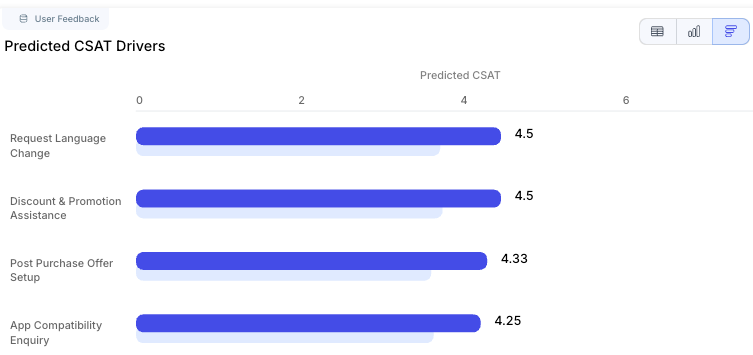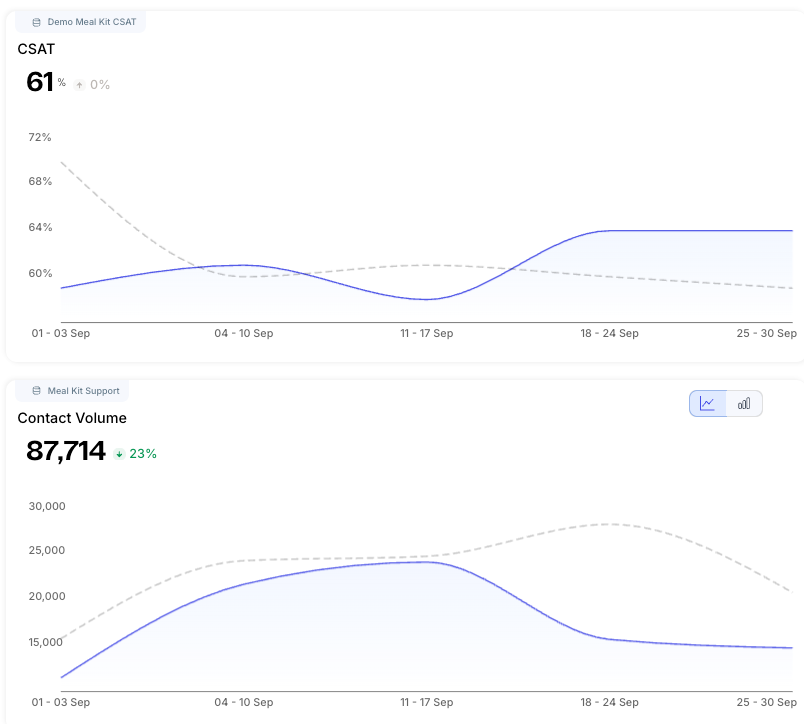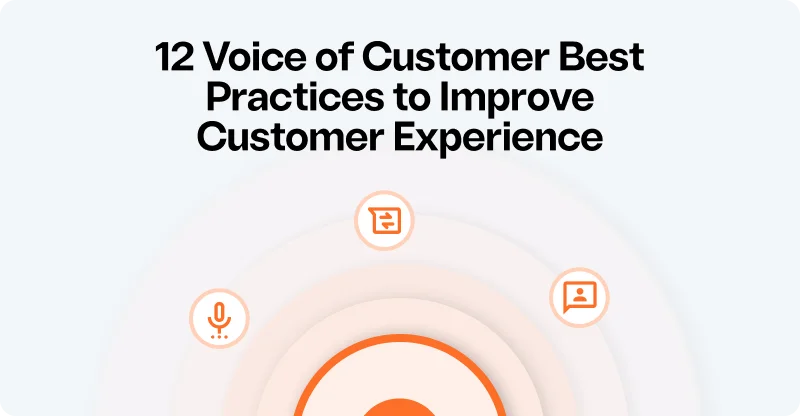Most subscription businesses don't lose customers because their product is bad.
They lose them because support and CX teams are drowning in feedback across dozens of channels with no clear way to spot what's actually breaking.
By the time you notice a pattern in quarterly surveys, you've already lost customers to preventable issues. This is why the top VoC programs in 2026 use real-time analysis to detect churn risks early, prioritize what matters, and fix problems before they cost you revenue.
This guide covers 12 Voice of Customer best practices that help CX and support leaders turn scattered feedback into retention actions. You'll learn how to collect insights from every touchpoint, use AI to spot patterns instantly, and align teams around the issues that actually drive churn.
12 Best Practices for Voice of the Customer in 2026
Here are the Voice of Customer best practices you need to adopt to convert customer feedback into actionable insights
1. Collect feedback across multiple touchpoints
Relying on a single feedback channel gives an incomplete picture of customer experience. Collect insights from various sources, such as support tickets, live chat, email conversations, website analytics, in-app forms, and social media mentions.

Each touchpoint adds a different layer of understanding: support tickets expose recurring issues, live chats reveal usability concerns, and social media highlights real-time sentiment.
Website behavior data, such as high bounce or exit rates, can show where customers struggle most. Combining these insights creates a complete, data-backed understanding of what customers feel and expect.
Modern VoC tools can automatically gather and categorize this information in one dashboard, helping teams quickly spot trends. Review this data regularly so teams can act before problems escalate.
2. Ensure feedback is actionable: Categorize and prioritize insights
Group comments into categories like product quality, pricing, customer support, delivery, or usability. This makes it easier to identify which themes need attention first.
Once categorized, assign priority levels: urgent (critical issues affecting many users), high (frequent but manageable), medium (moderate), and low (minor suggestions). Use quantitative metrics such as NPS, CSAT, and churn rate to measure the severity of each issue.
AI-driven VoC platforms can automate categorization, keyword tagging, and sentiment analysis, enabling teams to process large volumes of feedback efficiently.
After setting priorities, assign clear ownership to departments with deadlines for resolution. Track progress to ensure insights turn into action.
3. Use AI for sentiment analysis and anomaly detection
Sentiment analysis tools use natural language processing (NLP) to classify comments as positive, neutral, or negative.
For instance, if customers repeatedly mention “slow loading” or “payment error,” AI tools can detect these patterns instantly and alert the relevant team.
Machine learning models also identify anomalies, such as a sudden surge in negative reviews after a new product release. Beyond keywords, advanced AI can recognize tone and emotion, providing deeper context for each message. Some systems even predict customer churn based on complaint frequency and intensity.
Integrating AI into VoC ensures real-time monitoring, faster responses, and reduced human bias. As models learn from new data, they deliver more accurate predictions and smarter insights. This enables teams to stay ahead of customer issues.
4. Use real-time alerts to act on negative feedback promptly
Immediate responses to negative feedback can prevent customer churn. Set automated alerts for triggers such as poor survey scores, refund requests, or negative social media mentions. These notifications should be routed directly to the appropriate department support, product, or marketing for fast resolution.
For example, if a user posts a complaint on X (Twitter), your team can respond within minutes with an apology or fix. Tools like Zendesk or HubSpot can automatically escalate critical issues.
Quick responses not only resolve problems but also show customers that their feedback matters.
This builds trust, strengthens loyalty, and turns potential detractors into advocates. Over time, consistent responsiveness enhances your reputation for excellent customer care.
5. Align CX, support, and product teams around VoC insights
To improve customer experience effectively, every team must work from the same data. CX teams analyze trends and satisfaction metrics, support teams understand daily pain points, and product teams use these insights to refine features.
Hold regular cross-functional meetings to discuss top feedback themes, prioritize actions, and measure progress. Use shared dashboards to monitor NPS, ticket volume, and sentiment trends.
This alignment ensures all teams move toward shared goals, better usability, faster responses, and higher satisfaction. Assign measurable outcomes to each initiative so everyone is accountable for improvement.
Unified collaboration speeds up problem-solving and ensures consistent experiences across all customer touchpoints.
6. Integrate VoC data with CRM systems
Integrating VoC with CRM platforms gives you a complete picture of each customer’s history, sentiment, and behavior. Tools like Intercom, Freshdesk, or Salesforce can connect feedback data with purchase records, support logs, and engagement history.
With this integration, teams can see patterns, such as how often an unhappy customer contacts support before leaving, and how satisfaction changes after product updates.
CRMs can also trigger automated tasks such as notifying account managers or creating follow-up tickets when negative feedback is detected.
This helps personalize communication. Agents can reference past concerns in conversations, showing genuine attention. On a larger scale, VoC-CRM integration allows segmentation by sentiment, region, or product usage, giving leadership a clear view for retention and upselling strategies.
7. Regularly track and measure customer satisfaction metrics (NPS, CSAT, CES)
Consistent tracking of customer satisfaction metrics helps identify what’s working and what needs fixing. NPS (Net Promoter Score) measures loyalty and the likelihood that customers will recommend you.
CSAT (Customer Satisfaction Score) evaluates satisfaction after specific interactions. CES (Customer Effort Score) measures how easy it is for customers to complete key tasks.

Send surveys after significant interactions, such as purchases, onboarding, or support calls. Compare results over time to detect performance trends. Combine quantitative scores with open-ended responses to understand the reasons behind ratings.
If NPS declines, review qualitative feedback to uncover root causes. Sharing these metrics across teams encourages transparency, accountability, and continuous improvement. Over time, satisfaction tracking becomes a key predictor of retention and growth.
8. Build a customer feedback loop: Use insights to improve products and services
A strong VoC program doesn’t stop at listening to and acting on feedback. Once you identify the top issues, develop clear action plans. For example, if customers report slow response times, invest in better training or automation.

After implementing improvements, close the loop by communicating changes back to customers. Share updates through newsletters, emails, or app notifications to show that their input made a difference.
Internally, review progress, assign responsibilities, and measure how updates affect satisfaction scores. This cycle of listening, improving, and informing builds trust and encourages ongoing feedback.
When customers see real change from their suggestions, they become long-term brand advocates.
9. Create personalized experiences based on feedback
Customer feedback can drive meaningful personalization. Segment customers based on satisfaction scores, purchase history, or engagement level, then tailor experiences to their needs.
If users find a feature confusing, create tutorials or in-app guidance for that group. If repeat buyers praise a product, reward them with early access or loyalty discounts.
Support agents can also adapt tone and communication style based on sentiment analysis. Over time, personalization improves satisfaction, reduces churn, and fosters stronger emotional connections between your brand and customers.
10. Use omnichannel feedback for a holistic view of customer sentiment
Customers interact across multiple platforms: email, chat, social media, and apps. Each reveals unique insights. An omnichannel VoC approach consolidates these sources into one system, giving teams a complete understanding of sentiment.
For instance, a user might praise your support team on chat but complain about pricing on social media. Reviewing all interactions together provides context that single-channel analysis would miss.
Unified dashboards help compare satisfaction across platforms, spot recurring patterns, and ensure consistent responses. This comprehensive view prevents duplication of effort, strengthens collaboration, and enhances the overall customer experience.
11. Engage with customers on social media for open-ended feedback
Social media is a direct line to customer sentiment. People share honest opinions, both positive and negative, without filters.
Monitor mentions, hashtags, and tags to spot both praise and complaints in real time. Respond quickly with empathy and practical solutions. Use social listening tools to identify trending concerns or feature requests.
Engage proactively by asking open-ended questions like, “What’s one feature you’d love to see next?” This builds community and positions your brand as approachable and attentive. Over time, this kind of engagement strengthens relationships and boosts brand loyalty.
12. Focus on proactive retention rather than just reactive measures
Instead of waiting for customers to complain, anticipate their needs. Use historical feedback and behavioral analytics to identify early signs of dissatisfaction, declining activity, low engagement, or negative sentiment.
Predictive analytics can highlight at-risk accounts so you can intervene early. For instance, if users often churn after onboarding issues, send follow-up tutorials or personal check-ins.
Proactive communication shows customers that your brand cares about their success, not just their payments. This forward-looking approach reduces churn, increases satisfaction, and turns potential losses into retention wins.
Why SentiSum is the Best Tool for Voice of Customer Best Practices
Most CX teams know what they should be doing. The problem is doing it at scale without burning out your analysts or waiting weeks for insights.
You can't manually categorize 50,000 support tickets a month. You can't spot emerging churn patterns across Zendesk, Trustpilot, app reviews, and social media by reading through spreadsheets. And by the time you compile quarterly reports, customers are already gone.
SentiSum is an AI-native VoC platform that makes these 12 practices actually achievable for subscription businesses. Here's how:
1. Automatic feedback collection across every channel
SentiSum connects directly to your existing tools (Zendesk, Intercom, Salesforce, Gorgias, Trustpilot, app stores, social media) and pulls in every piece of feedback automatically. No manual exports. No CSV uploads. No data silos.
Your team gets one unified view of what customers are saying across support tickets, chat conversations, reviews, surveys, and social mentions. This means you're not missing critical feedback just because it came through an unexpected channel.
2. AI-powered analysis in real time
Kyo, SentiSum's AI agent, highlights anomalies, detects churn risks, and suggests next-best actions in real time.
It doesn't just tag feedback by topic. It understands context, detects sentiment shifts, and identifies root causes behind customer frustration.

When checkout errors spike 40% overnight, Kyo alerts your team immediately with the pattern, severity, affected customer segments, and suggested actions.
So, you're fixing issues only hours after they emerge, not weeks later when the damage is done.
3. Churn detection before customers leave
SentiSum analyzes complaint frequency, sentiment intensity, and behavior patterns to predict which customers are at risk. You get early warning alerts when specific accounts show signs of churning, giving your retention team time to intervene.
It's solid pattern recognition across thousands of customer interactions that spots the signals human analysts miss.
4. Cross-functional alignment on what actually matters
Your support team sees different data than the product. Product prioritizes differently than leadership. Everyone's guessing at what's most urgent.
SentiSum gives every team the same real-time dashboard showing which issues are driving the most negative sentiment, affecting the most customers, and correlating with churn.
Support, product, and CX leaders can finally prioritize the same problems and measure the same outcomes.
5. Measurable Retention Impact
SentiSum does more than just show you sentiment scores. It connects feedback directly to customer accounts, so you can see which issues correlate with churn, which improvements drive retention, and what ROI your CX investments are delivering.
Teams typically spot churn risks 3-4 weeks earlier than traditional survey-based approaches, giving them time to save customers instead of conducting exit interviews.
Conclusion
A suitable Voice of the Customer program helps you understand what people like, what frustrates them, and what they expect next. When you act on feedback and show customers their opinions matter, you earn their trust and loyalty.
With tools like SentiSum, you can gather feedback from all channels, find key insights quickly, and fix issues before they grow.
Book a Demo with SentiSum today to see how you can turn customer feedback into action, improve satisfaction, and reduce churn.
Heading 1
Heading 2
Heading 3
Heading 4
Heading 5
Heading 6
Lorem ipsum dolor sit amet, consectetur adipiscing elit, sed do eiusmod tempor incididunt ut labore et dolore magna aliqua. Ut enim ad minim veniam, quis nostrud exercitation ullamco laboris nisi ut aliquip ex ea commodo consequat. Duis aute irure dolor in reprehenderit in voluptate velit esse cillum dolore eu fugiat nulla pariatur.
Block quote
Ordered list
- Item 1
- Item 2
- Item 3
Unordered list
- Item A
- Item B
- Item C
Bold text
Emphasis
Superscript
Subscript

.webp)







.png)
.webp)
.svg)
.svg)







